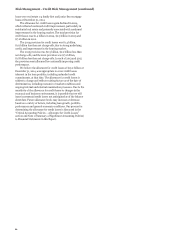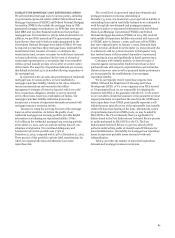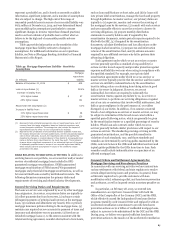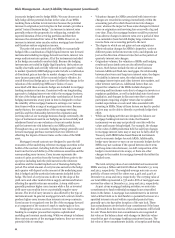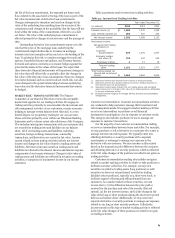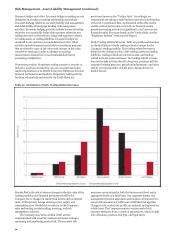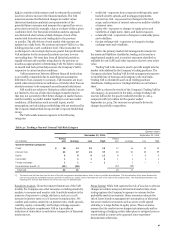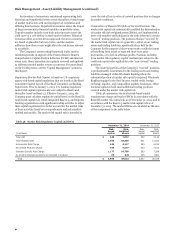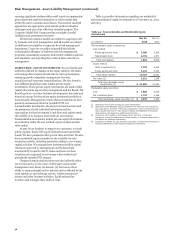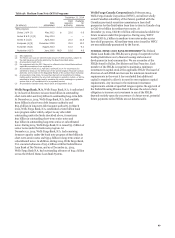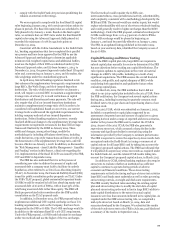Wells Fargo 2014 Annual Report Download - page 93
Download and view the complete annual report
Please find page 93 of the 2014 Wells Fargo annual report below. You can navigate through the pages in the report by either clicking on the pages listed below, or by using the keyword search tool below to find specific information within the annual report.
VaR is a statistical risk measure used to estimate the potential
loss from adverse moves in the financial markets. The VaR
measures assume that historical changes in market values
(historical simulation analysis) are representative of the
potential future outcomes and measure the expected loss over a
given time interval (for example, 1 day or 10 days) within a given
confidence level. Our historical simulation analysis approach
uses historical observations of daily changes of each of the
market risk factors from each trading day in the previous
12 months. The risk drivers of each market risk exposure are
updated on a daily basis. We measure and report VaR for a 1-day
holding period at a 99% confidence level. This means that we
would expect to incur single day losses greater than predicted by
VaR estimates for the measured positions one time in every
100 trading days. We treat data from all historical periods as
equally relevant and consider using data for the previous 12
months as appropriate for determining VaR. We believe using a
12-month look back period helps ensure the Company’s VaR is
responsive to current market conditions.
VaR measurement between different financial institutions
is not readily comparable due to modeling and assumption
differences from company to company. VaR measures are more
useful when interpreted as an indication of trends rather than an
absolute measure to be compared across financial institutions.
VaR models are subject to limitations which include, but are
not limited to, the use of historical changes in market factors
that may not accurately reflect future changes in market factors,
and the inability to predict market liquidity in extreme market
conditions. All limitations such as model inputs, model
assumptions, and calculation methodology risk are monitored by
the Corporate Market Risk Group and the Corporate Model Risk
Group.
The VaR models measure exposure to the following
categories:
Table 47: Trading 1-Day 99% General VaR Risk Category
• credit risk - exposures from corporate credit spreads, asset-
backed security spreads, and mortgage prepayments.
• interest rate risk - exposures from changes in the level,
scope, and curvature of interest rate curves and the volatility
of interest rates.
• equity risk - exposures to changes in equity prices and
volatilities of single name, index, and basket exposure.
• commodity risk - exposures to changes in commodity prices
and volatilities.
• foreign exchange risk - exposures to changes in foreign
exchange rates and volatilities.
VaR is the primary market risk management measure for
the assets and liabilities classified as trading and is used as a
supplemental analysis tool to monitor exposures classified as
available for sale (AFS) and other exposures that we carry at fair
value.
Trading VaR is the measure used to provide insight into the
market risk exhibited by the Company’s trading positions. The
Company calculates Trading VaR for risk management purposes
to establish line of business and Company-wide risk limits.
Trading VaR is calculated based on all trading positions
classified as trading assets or trading liabilities on our balance
sheet.
Table 47 shows the results of the Company’s Trading VaR by
risk category. As presented in the table, average Trading VaR
was $21 million for the quarter ended December 31, 2014,
compared with $17 million for the quarter ended
September 30, 2014. The increase was primarily driven by
changes in portfolio composition.
Quarter ended
(in millions) Period
end Average
December 31, 2014
Low High Period
end Average
September 30, 2014
Low High
General VaR Risk Categories
Credit $ 10 14 10 19 17 16 12 20
Interest rate 24 27 19 37 29 30 25 39
Equity
Commodity
Foreign exchange
Diversification benefit (1)
9
1
1
(23)
8
1
1
(30)
6
1
—
12
2
1
8
1
—
(37)
7
1
1
(38)
6
1
—
9
1
1
Total VaR 22 21 18 17
(1) The period-end VaR was less than the sum of the VaR components described above, which is due to portfolio diversification. The diversification effect arises because the
risks are not perfectly correlated causing a portfolio of positions to usually be less risky than the sum of the risks of the positions alone. The diversification benefit is not
meaningful for low and high metrics since they may occur on different days.
Sensitivity Analysis Given the inherent limitations of the VaR Stress Testing While VaR captures the risk of loss due to adverse
models, the Company uses other measures, including sensitivity changes in markets using recent historical market data, stress
analysis, to measure and monitor risk. Sensitivity analysis is the testing captures the Company’s exposure to extreme but low
measure of exposure to a single risk factor, such as a 0.01% probability market movements. Stress scenarios estimate the
increase in interest rates or a 1% increase in equity prices. We risk of losses based on management’s assumptions of abnormal
conduct and monitor sensitivity on interest rates, credit spreads, but severe market movements such as severe credit spread
volatility, equity, commodity, and foreign exchange exposure. widening or a large decline in equity prices. These scenarios
Sensitivity analysis complements VaR as it provides an assume that the market moves happen instantaneously and no
indication of risk relative to each factor irrespective of historical repositioning or hedging activity takes place to mitigate losses as
market moves. events unfold (a conservative approach since experience
demonstrates otherwise).
91



